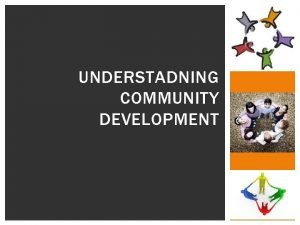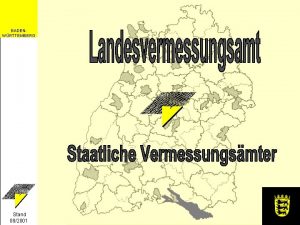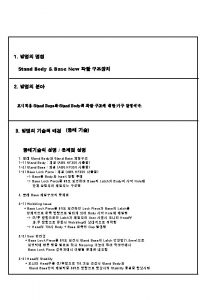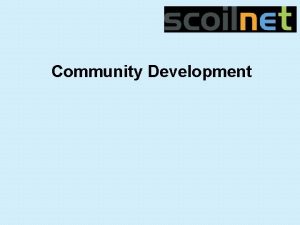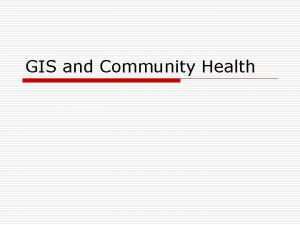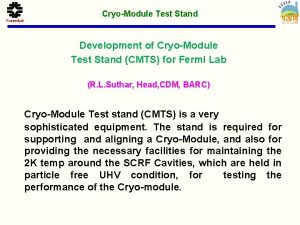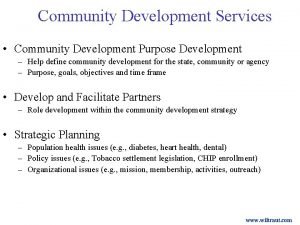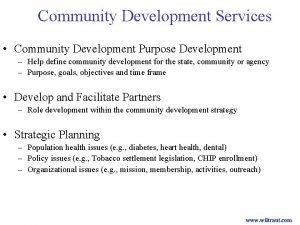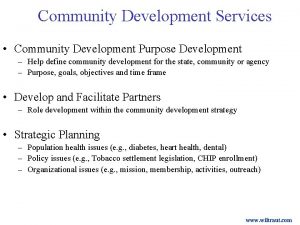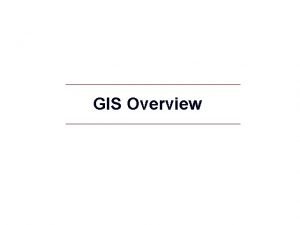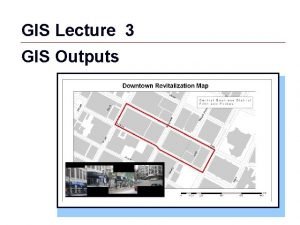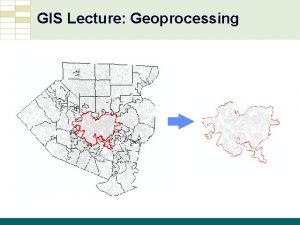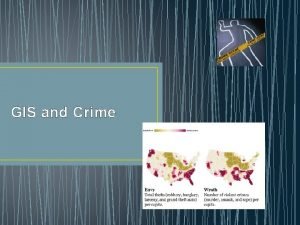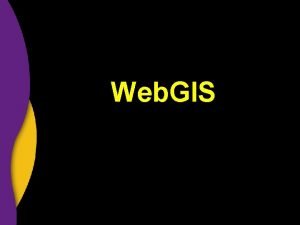GIS FOR COMMUNITY DEVELOPMENT WHAT DOES GIS STAND




















- Slides: 20

GIS FOR COMMUNITY DEVELOPMENT

WHAT DOES GIS STAND FOR? � Geographic Information Systems � often defined as a computerized database management system for capture, storage, retrieval, analysis, and display of spatial data. www. cml. upenn. edu/what_is_gis. htm � Sometimes referred to as method of digital mapping that links data to it’s physical location. Hardware and Software Data Mapping Standards GIS Savvy Users GIS

HOW GIS WORKS GIS breaks anything that has a geographic location into: § Vector Data: § Points - GPS points, address points, tree locations, etc. § Lines – rivers, railroads, streets, corridors, etc. § Polygons – political boundaries, lakes, building footprints, etc. Image ource: www. esri. com 2013

HOW GIS WORKS Features are stored as layers and are layered on top of the first one to show spatial patterns and relationships Image source: www. esri. com 2013

GIS is in reality nothing more than a large database with a geographic component. The power behind GIS is in the attributes attached to the features. . . allows for

WHY USE GIS? Layer the different datasets to do geographic analysis (analysis based on geographic location) Map Where Things Are – parks, sidewalks, groceries, bus stops Map Quantities - population Map Densities – population density (how many people per square mile) Find What’s Inside – How many people (groceries, parks, trails) inside a neighborhood (town, county, study area). Find What’s Nearby – How many bus stops (green spaces, crimes) are located or were reported within a 10 minute walking distance of a neighborhood (school, store, university) Map Change – urban sprawl, zoning changes source: www. esri. com 2013

WHY USE GIS FOR COMMUNITY DEVELOPMENT? • To show relationships among several factors or issues within a community. • To show you where to concentrate your efforts. • To better understand the community you are working in by providing a picture of the area’s assets or weaknesses. • Because it’s fast: GIS is the quickest and most efficient method of creating maps and graphics that provide a picture of not only the geographic, but of the social, demographic, environmental, political, and other aspects of an area as well. • GIS maps make powerful presentation tools. • GIS maps can help influence policy. Source: KU Work Group for Community Health and Development. (2014). Chapter 3, Section 10: Conducting Concerns Surveys. Lawrence, KS: University of Kansas. Retrieved January 2, 2014, from the Community Tool Box: http: //ctb. ku. edu/en/table-of-contents/assessment/assessing-communityne. . .

WHO USES GIS? • Government Agencies (from small municipalities to federal government) • Health and Human Services Agencies • Community Involvement Groups (i. e. . , watch dog groups, activists, advocates) • Environmental Agencies • Researchers and Educators • Policy Makers and Community Developers • Corporations and Firms Source: KU Work Group for Community Health and Development. (2014). Chapter 3, Section 10: Conducting Concerns Surveys. Lawrence, KS: University of Kansas. Retrieved January 2, 2014, from the Community Tool Box: http: //ctb. ku. edu/en/table-of-contents/assessment/assessing-communityne. . .

DATA What makes data “spatial”? § Must have a geographic component § Address § Lat/Long coordinates § Tied to a location such as a state, city, region, service area, census block. When should you create and share maps of your data? § Only if it enhances the data and makes it easier for users to understand comprehend!! § A picture is worth a thousand words!

YOUR DATA • GPS • Georeferencing - a historic map or image • Geocoding addresses • Heads-up-digitizing • Analysis tools with GIS software • Mobile mapping – cellphones, tablets • Upload from a database (Excel, Access, etc. ) • Stream from Twitter or other social media

ONLINE DATA AND MAPPING: • Local County GIS offices • Indiana. Map (or other state clearinghouse) • Census. gov (google “American Factfinder”) • Indiana Spatial Data Portal • SAVI (IUPUI Polis Center) • Census. gov • The National Map • National Historic GIS – historic census data in a GIS format. • HUD. gov • NOAA • Community Commons • Center for Disease Control (CDC)

GIS SOFTWARE AND ONLINE MAPPING APPS

ESRI ARCGIS DESKTOP Free Version: Arc. GIS Explorer Desktop: http: //www. esri. com/software/arcgis/explorer-desktop

LOCAL COUNTY GIS WEBSITES http: //beacon. schneidercorp. com/Default. aspx

INDIANAMAP http: //www. indianamap. org/

STATS INDIANA http: //www. stats. indiana. edu/maptools/interactive. asp

COMMUNITY COMMONS http: //www. communitycommons. org/maps-data/

GOOGLE MAPS Create and share maps in a matter of minutes by uploading your own database with records tied to a location (address, lat/long). http: //maps. google. com

ARCGIS ONLINE Upload your own data, or create it in Arc. GIS Online, user data created and shared by others, create map applications and share and/or embed on your own webpage. Thousands of user created datasets to choose from. Free and subscription versions available. Arc. GIS. com http: //www. arcgis. com/home/gallery. html Image source: www. esri. com 2013

QUESTIONS? Contact: Angela Gibson GIS Specialist Ball State University Libraries GIS Research and Map Collection asgibson 2@bsu. edu 285 -1097
 What is the history of community development in tanzania?
What is the history of community development in tanzania? Purpose of community development
Purpose of community development Stand up for jesus
Stand up for jesus Nanny shine has got
Nanny shine has got Fspos vägledning för kontinuitetshantering
Fspos vägledning för kontinuitetshantering Typiska novell drag
Typiska novell drag Nationell inriktning för artificiell intelligens
Nationell inriktning för artificiell intelligens Ekologiskt fotavtryck
Ekologiskt fotavtryck Varför kallas perioden 1918-1939 för mellankrigstiden
Varför kallas perioden 1918-1939 för mellankrigstiden En lathund för arbete med kontinuitetshantering
En lathund för arbete med kontinuitetshantering Kassaregister ideell förening
Kassaregister ideell förening Tidbok
Tidbok Sura för anatom
Sura för anatom Densitet vatten
Densitet vatten Datorkunskap för nybörjare
Datorkunskap för nybörjare Tack för att ni lyssnade bild
Tack för att ni lyssnade bild Att skriva en debattartikel
Att skriva en debattartikel Delegerande ledarskap
Delegerande ledarskap Nyckelkompetenser för livslångt lärande
Nyckelkompetenser för livslångt lärande Påbyggnader för flakfordon
Påbyggnader för flakfordon Tryck formel
Tryck formel

